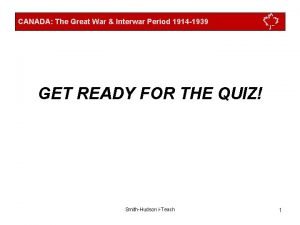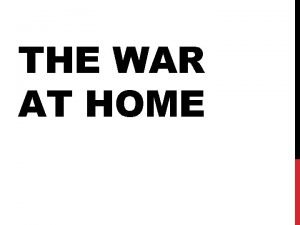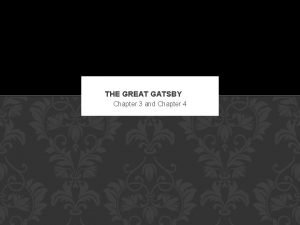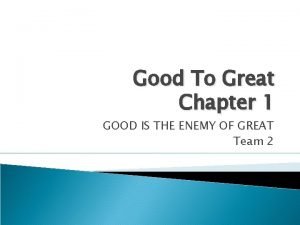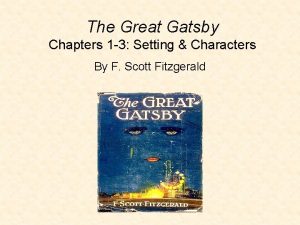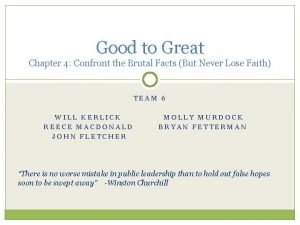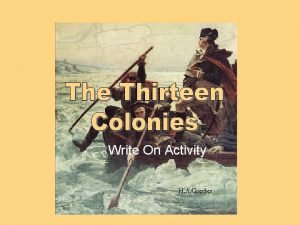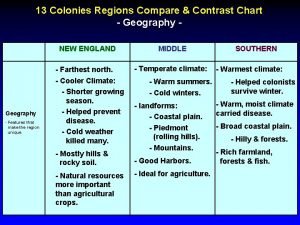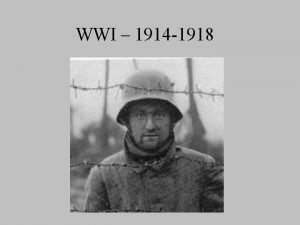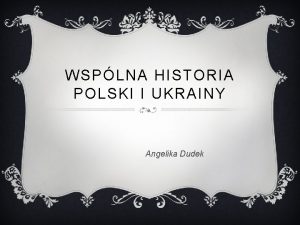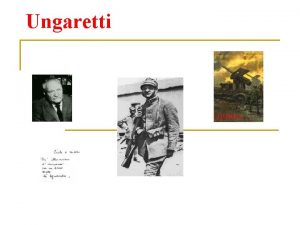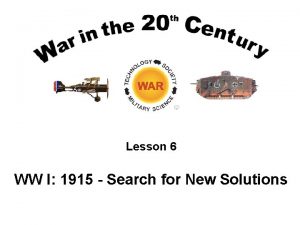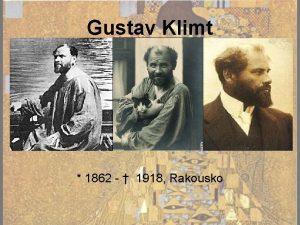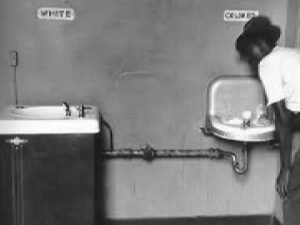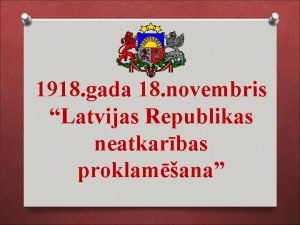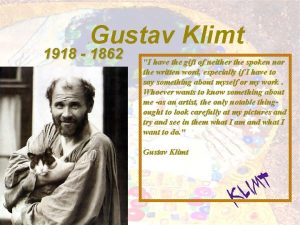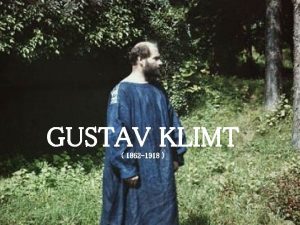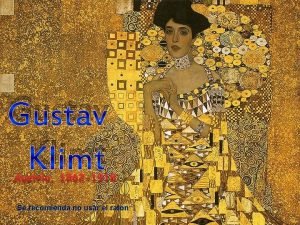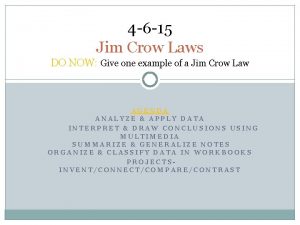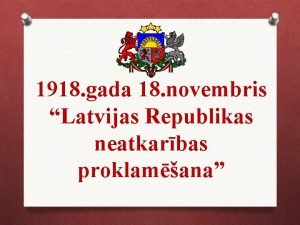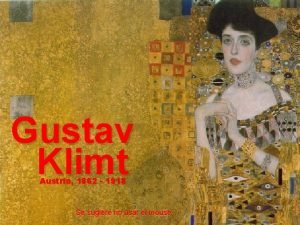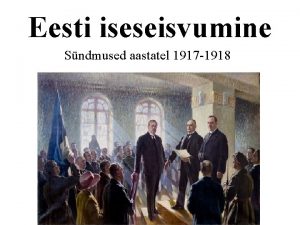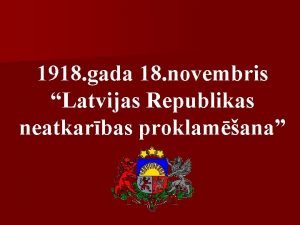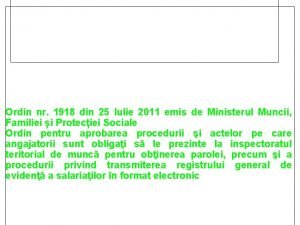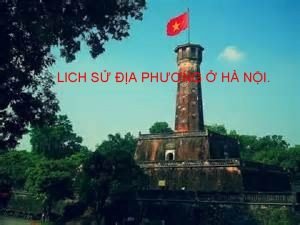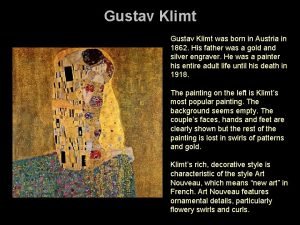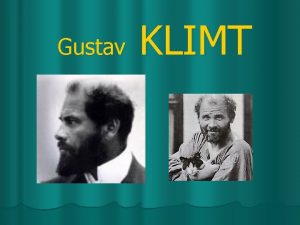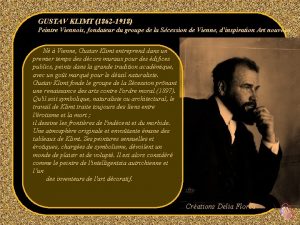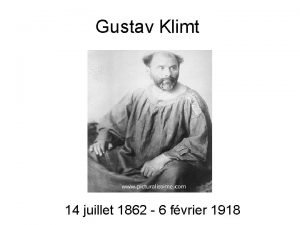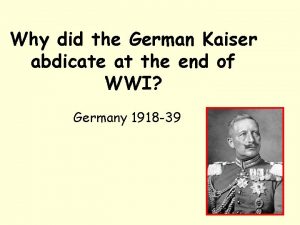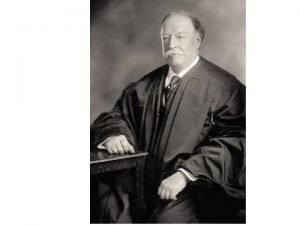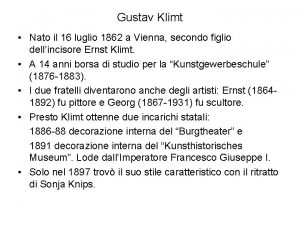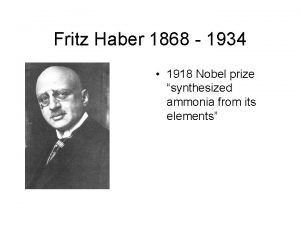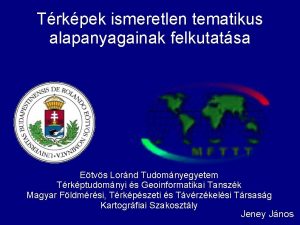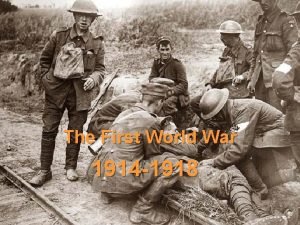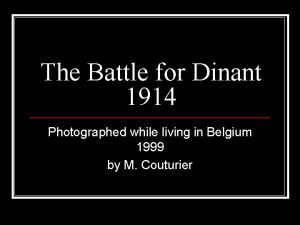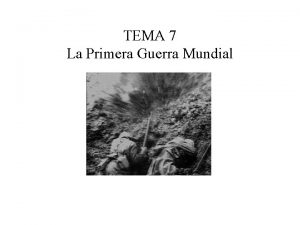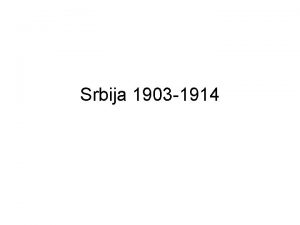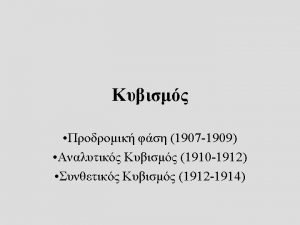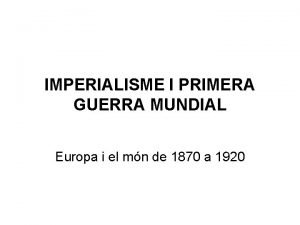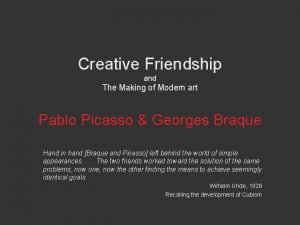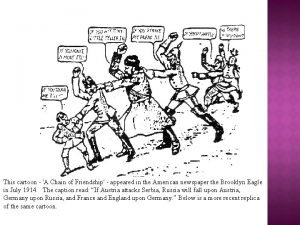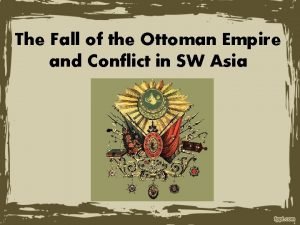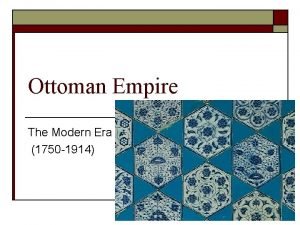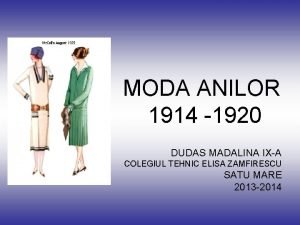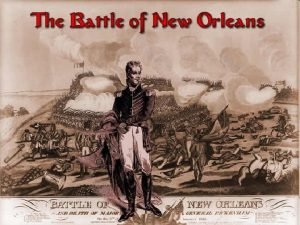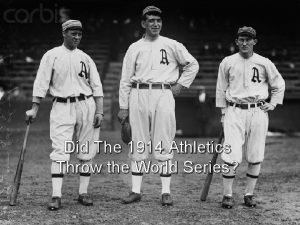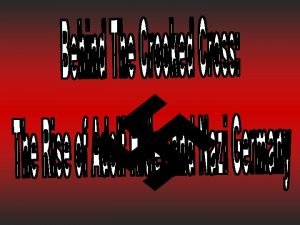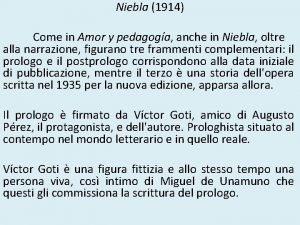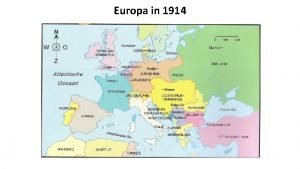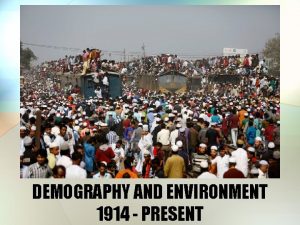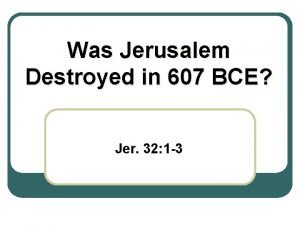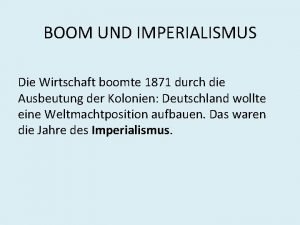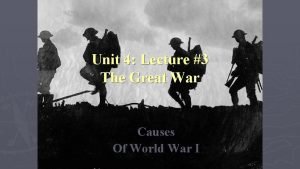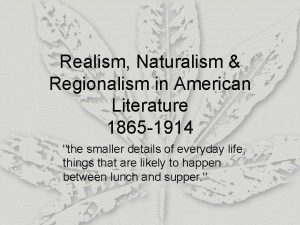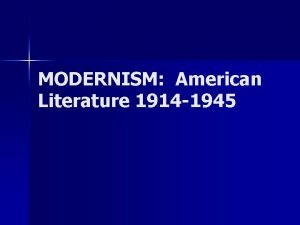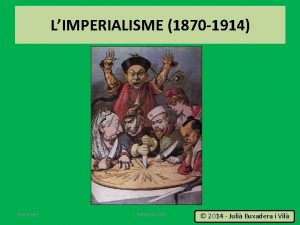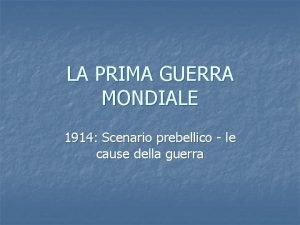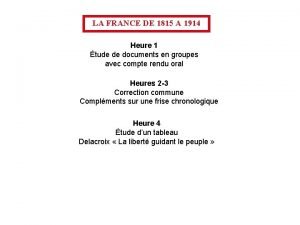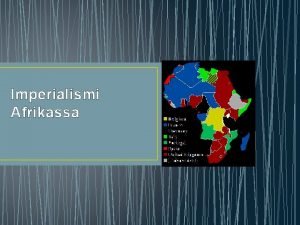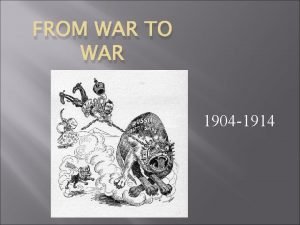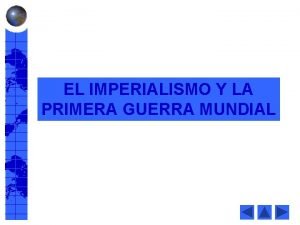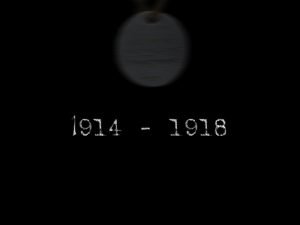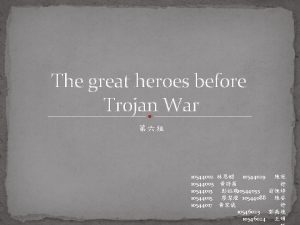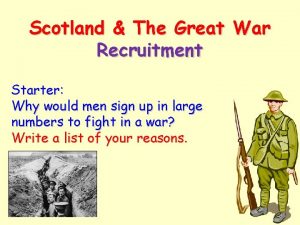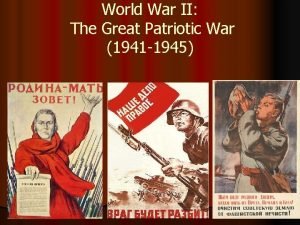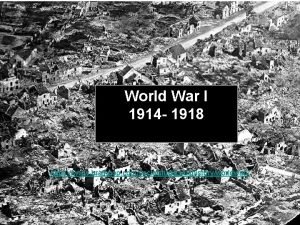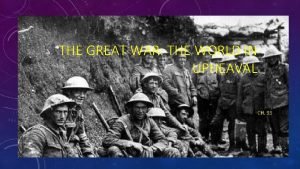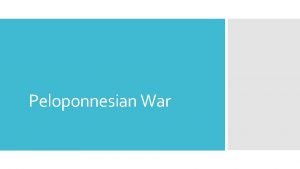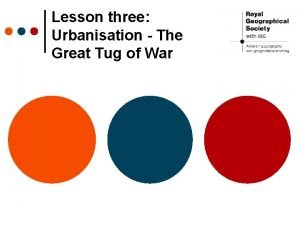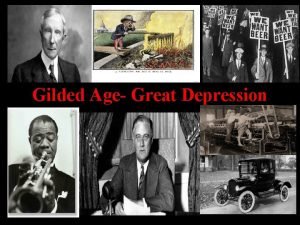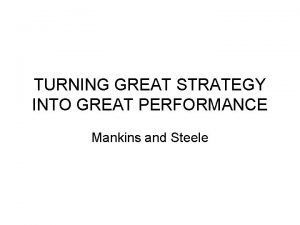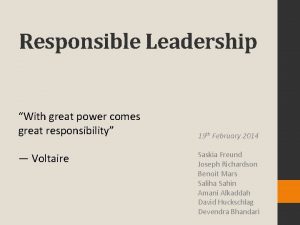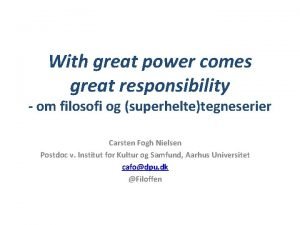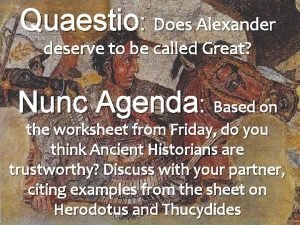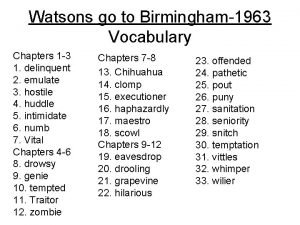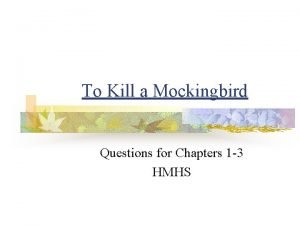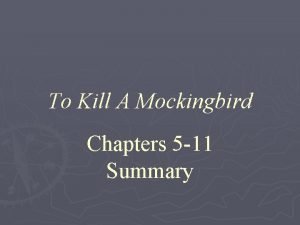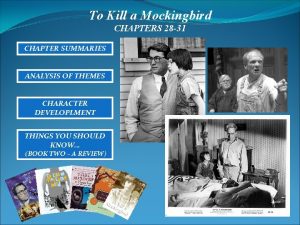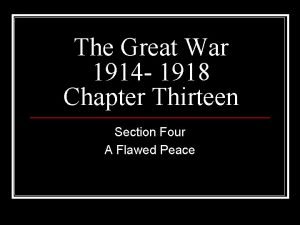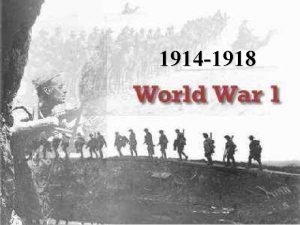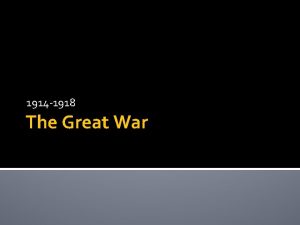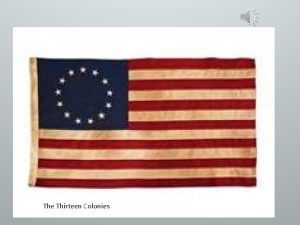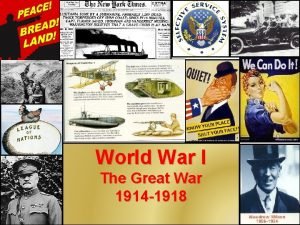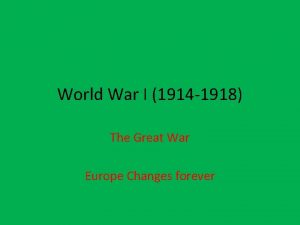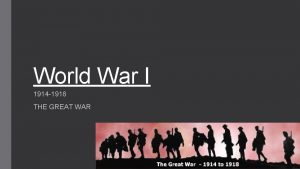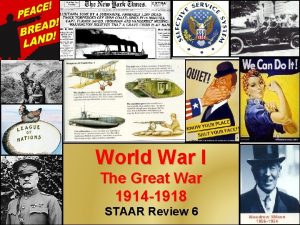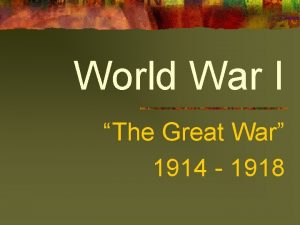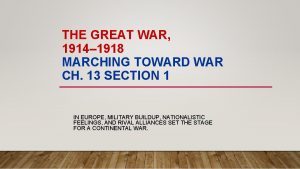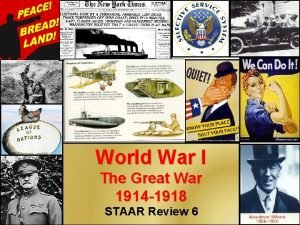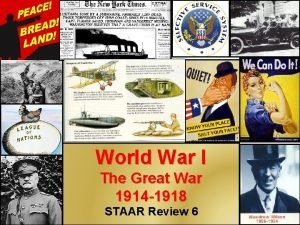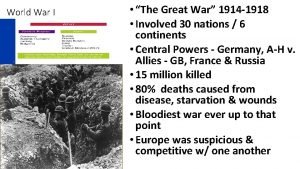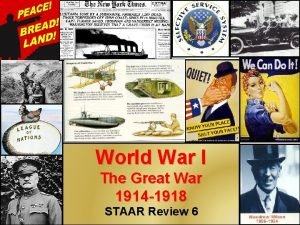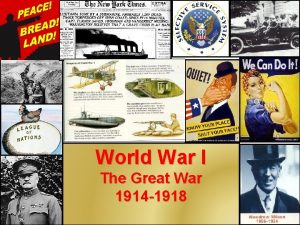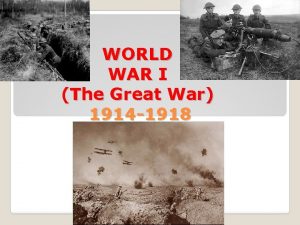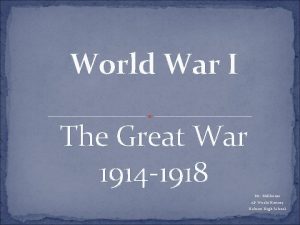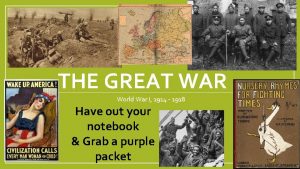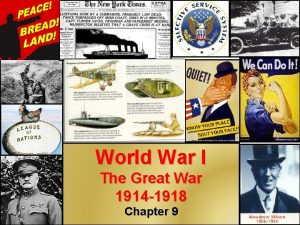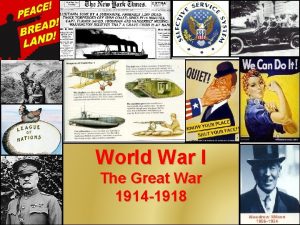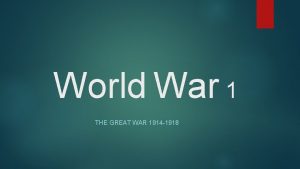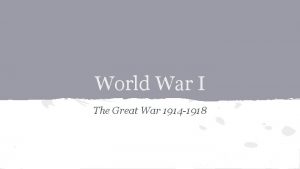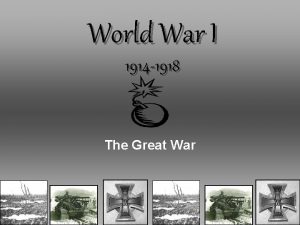1914 1918 The Great War Chapter Thirteen Chapters





















![The Major Players: 1914 -17 Allied Powers: Central Powers: Nicholas II [Rus] George V The Major Players: 1914 -17 Allied Powers: Central Powers: Nicholas II [Rus] George V](https://slidetodoc.com/presentation_image_h2/ff02b1a84a1b23ccfe766ae98d5cde41/image-22.jpg)


























































![Poison Gas The next thing I knew [I] was being carried on a stretcher Poison Gas The next thing I knew [I] was being carried on a stretcher](https://slidetodoc.com/presentation_image_h2/ff02b1a84a1b23ccfe766ae98d5cde41/image-81.jpg)

































































































- Slides: 178

1914 -1918: The Great War Chapter Thirteen

Chapters in Brief - Questions 1. What factors led to World War I? 2. Why did a revolution occur in Russia? 3. What was the war like on the Western Front? 4. How did the war change the countries that fought it?

Chapters in Brief - Answers 1. What factors led to World War I? > nationalism – caused competition among nations > imperialism > growing arms race and mobilization plan > system of alliances – pushed Europe into two armed camps

Chapters in Brief - Answers 2. Why did a revolution occur in Russia? > the czar did not respond to the increasing calls for democracy > the economy was in poor condition > soldiers were tired of fighting > dedicated revolutionaries worked to bring about this revolution

Chapters in Brief - Answers 3. What was the war like on the Western Front? > it was characterized by the suffering of trench warfare – with mud, starvation, disease, and constant bombardment – interrupted by occasional attacks that produced great death and destruction because of new war technologies

Chapters in Brief - Answers 4. How did the war change the countries that fought it? > total war – people at home had to contribute to the war effort; it demanded all the resources of the countries that fought it > governments took control of factories, rationed food and other goods, and used propaganda to generate support > women played a larger role in the economies

Should You ALWAYS Support an Ally? Ø World War I has begun. You are the leader of a European country and must decide what to do. Your nation is one of several that have agreed to support each other in the event of war. Some of your allies already have joined the fight. You oppose thought of war and fear that joining will lead to even more lives lost. Yet, you believe in being loyal to your allies. You also worry that your rivals want to conquer all of Europe – and if you don’t join the war now, your country may end up having to defend itself. Ø Should you always support a friend, no matter what he or she does? Ø What might be the long-term consequences of refusing to help an ally?

Background Information Ø What do you already know about WWI? – – – When was it fought? Who was involved? Where were the battles fought? What types of weapons were used? Who won? What other names is WWI known under?

World War I Objective Summarize the causes, events, and effects of World War I

World War I Overview Strong national feelings and strong armies produced competition between European nations and led to war. The system of alliances turned a local conflict into a general European war and then a world war. Horribly brutal, it changed the lives of millions and transformed Russia when it helped cause a revolution.

Section One Marching Toward War

Chapters in Brief In the late 1800 s, many people in Europe joined groups to promote peace. They met several times between 1843 and 1907 to urge their cause. While this movement for peace was building, so were other developments. These other factors would soon plunge Europe into war. One of those factors was nationalism – the deep feeling of attachment to one’s own nation. This force helped unify the people of a country. It also helped promote competition between countries. By 1900, six nations were rivals for power in Europe. These nations, called the Great Powers, were Germany, Austria-Hungary, Great Britain, Russia, Italy, and France. They competed economically, and they competed for neighboring land. Imperialism was another force that helped lead to war. France and Germany, each seeking control of parts of Africa, almost came to war twice in the early 1900 s. Such competed economically, and they competed for neighboring land. The third factor leading to war was a growing arms race. Each country in Europe – except Great Britain – built a large army. Generals in each country made complex plans to be able to mobilize their armies or rush troops to battle as quickly as possible.

Chapters in Brief Growing rivalry led the nations to make alliances with one another. Fearing that France would want revenge for its defeat in the Franco. Prussian War, Otto von Bismarck set out to isolate France. In 1879, he formed a Triple Alliance with Austria-Hungary and Italy, and a treaty with Russia. However, when Wilhelm II became Kaiser, or emperor, of Germany, he did not want to share power. He forced Bismarck out and followed his own policy. He let the agreement with Russia expire, and Russia quickly allied itself with France. This alliance meant that Germany would have to fight enemies on east and west borders If there were a war with either country. Wilhelm II then moved to make the German navy large. Britain grew alarmed and began to build more ships of its own. It made a Triple Entente alliance with France and Russia. The six Great Powers had now formed two camps: Germany, Austria-Hungary, and Italy against Britain, France, and Russia.

The First World War • Pre-Unit Video Clips (Causes of The Great War) Causes – part one (8: 42) • http: //www. youtube. com/watch? v=n 7 kp 3 vf 1 u. KA Causes – part two (7: 49) • http: //www. youtube. com/watch? v=gjl. Goe 1 mnw 0&feature=related

MAIN Causes of WWI Ø Militarism Ø Alliance System Ø Imperialism Ø Nationalism

MAIN Causes of WWI (continued) Ø Militarism - the development of armed forces and their use of a tool of diplomacy Ø each nation wanted stronger armed forces than those of any potential enemy Ø British and German shipyards competed to see who could build the largest navy Ø Alliance System - an alliance is a formal agreement or union between nations – an alliance provided a measure of international security because nations were reluctant to disturb the balance of power – one spark set off a major conflict

MAIN Causes of WWI (continued) Ø Imperialism - the policy of extending a nations’ authority over other countries - economically - militarily or politically - cultural superiority Ø Africa is an example of imperialistic powers taking over foreign lands and the rivalries that became of this

MAIN Causes of WWI (continued) Ø Nationalism - a devotion to the interest and culture of one’s nation - nationalism led to antagonistic rivalries among nations - in this atmosphere of competition, many feared Germany’s growing power in Europe.

European Alliance Systems Ø 1907 = two major alliance systems in Europe 1. Triple Entente – turns into the Allied Powers a. Britain b. France c. Russia 2. Triple Alliance – turns into the Central Powers a. Germany b. Austria-Hungary c. Italy

The Alliance System Triple Entente: Triple Alliance:

Two Armed Camps Allied Powers: Central Powers:
![The Major Players 1914 17 Allied Powers Central Powers Nicholas II Rus George V The Major Players: 1914 -17 Allied Powers: Central Powers: Nicholas II [Rus] George V](https://slidetodoc.com/presentation_image_h2/ff02b1a84a1b23ccfe766ae98d5cde41/image-22.jpg)
The Major Players: 1914 -17 Allied Powers: Central Powers: Nicholas II [Rus] George V [Br] Wilhelm II [Ger] Victor Emmanuel II [It] Enver Pasha [Turkey] Pres. Poincare [Fr] Franz Josef [A-H]

Europe in 1914

Militarism & Arms Race Total Defense Expenditures for the Great Powers [Ger. , A-H, It. , Fr. , Br. , Rus. ] in millions of £s. 1870 1880 1890 1900 1914 94 130 154 268 289 398 1910 -1914 Increase in Defense Expenditures France 10% Britain 13% Russia 39% Germany 73%

Economic & Imperial Rivalries

Aggressive Nationalism

Pan-Slavism: The Balkans, 1914 The “Powder Keg” of Europe Ø Nationalist uprisings Ø ethnic clashes Ø Nationalism was a powerful force Ø Serbia and Austria’s tensions steadily rose

Mobilization Ø Home by Christmas! Ø No major war in 50 years! Ø Nationalism! It's a long way to Tipperary, It's a long way to go; It's a long way to Tipperary, To the sweetest girl I know! Goodbye, Piccadilly, Farewell, Leicester Square, It's a long, long way to Tipperary, But my heart's right there!

Recruitment Posters

A Young Australian Recruit

Recruits of the Central Powers A German Soldier Says Farewell to His Mother Austro-Hungarians

New French Recruits

A German Boy Pretends to Be a Soldier


Recruitment Poster Activity This is an individual assignment: 1. Choose a country that you would like to create a recruitment poster for. 2. Create a “catch phrase” to have your citizens enlist into your country's military. 3. Draw a picture to promote the recruitment of military personnel. 4. Use color / be neat / be creative 5. Present to class (1 - 2 minutes) explaining your recruitment poster. GOAL: To make the students in your class want to join your country and its military! 15 points total = 10 (poster) / 5 (presentation)

The “Spark”

Archduke Franz Ferdinand & His Family

The “Spark” That Leads to War Ø June 1914, Archduke Franz Ferdinand, heir Austrian throne, visits Sarajevo, Bosnia to the Ø Archduke Franz Ferdinand was shot and assassinated because the Slavs were exercising nationalism Ø Austria-Hungary declared war on Serbia Ø led to the countries who were part of the alliance systems entering the war Ø The Great War had begun!

The Assassination: Sarajevo

The Assassin: Gavrilo Princip

The Murder of Archduke Franz Ferdinand Primary Reading On June 28, 1914, Austria-Hungary’s Archduke Franz Ferdinand was assassinated by Gavrilo Princip in Sarjevo, the capital of Bosnia. This excerpt from an eyewitness account by a fellow conspirator in the assassination plot explains why the attack took place, what happened during the attack, and how Princip, the 19 -year-old Serbian assassin, was captured.

The Murder of Archduke Franz Ferdinand The little clipping…declared that the Austrian Archduke Franz Ferdinand would visit Sarajevo, the capital of Bosnia, June 28, to direct army maneuvers in the neighboring mountains…. How dared Franz Ferdinand, not only the representative of the oppressor but in his own person an arrogant tyrant, enter Sarajevo on that day? Such an entry was a studied insult. June 28 is a date engraved deeply in the heart of every Serb…It is the day on which the old Serbian kingdom was conquered by the Turks at the Battle of Amselfelde in 1389. It is also the day on which the second Balkan War the Serbian arms took glorious revenge on the Turk for his old victory and for the years of enslavement.

The Murder of Archduke Franz Ferdinand That was no day for Franz Ferdinand, the new oppressor, to venture to the very doors of Serbia for a display of the force of arms which kept us beneath his heel. Our decision was taken almost immediately. Death to the tyrant! Then came the matter of arranging it…But her Gavrilo Princip intervened. Princip is destined to go down in Serbian history as one of her greatest heroes. The fateful morning dawned….

The Murder of Archduke Franz Ferdinand When Franz Ferdinand his retinue…passed Gabrinovic…he threw his grenade. It hit the side of the car, but Franz Ferdinand with presence of mind threw himself back and was uninjured. Several officers riding in his attendance were injured. The cars sped to the town hall…After the reception in the town hall General Potiorek, the Austrian commander, pleaded with Franz Ferdinand to leave the city, as it was seething with rebellion. The archduke was persuaded to drive the shortest way out of the city and to go quickly.

The Murder of Archduke Franz Ferdinand The road to the maneuvers was shaped like the letter V, making a sharp turn at the bridge over the River Nilgacka. Franz Ferdinand’s car…was forced to slow down for the turn. Here Princip had taken his stand. As the car came abreast he stepped forward from the curb, drew his automatic pistol from his coat and fired two shots. The first struck the wife of the archduke, the Archduchess Sofia, in the abdomen. She was an expectant mother. She died instantly. The second bullet struck the archduke close to the heart. He uttered only one word; ‘Sofia’ – a call to his stricken wife. Then his head fell back and he collapsed. He died almost instantly.

The Murder of Archduke Franz Ferdinand The officers seized Princip. They beat him over the head with the flat of their swords. They knocked him down, they kicked him, scraped the skin from his neck with the edges of their swords, tortured him, all but killed him. From Borijove Jevtic, “The Murder of Archduke Franz Ferdinand at Sarajevo, 28 June 1914” (1: 42) Assassination https: //www. youtube. com/watch? v=JEGVc. Spf. M 9 k&t=38 s

Who’s To Blame?

Russia and Great Britain World War I Ø Russia entered the war because Russia supported Serbia against Austria-Hungary Ø Great Britain entered the war when Germany declared war on France

The War of the Industrial Revolution: New Technology

New Weapons Ø Poison Gas 1. soldiers wore masks to protect themselves 2. introduced by Germans; both sides used 3. caused blindness, severe blisters, or death by choking Ø Machine Guns 1. fires ammunition automatically 2. could wipe out waves of attackers 3. made it difficult forces to advance

New Weapons (continued) Ø Tank 1. armored combat vehicle 2. moved on chain tracks 3. could cross many types of terrains 4. introduced by the British 1916 Ø Airplanes Ø Submarines 1. 1914 introduced by Germans 2. effective warship 3. primary weapon against ships was the torpedo

Tanks Ø first used at the battle of Flers Ø named because it looked like a tank of water on a train car Ø allowed safer passage across “No Man’s Land” Ø strange shape allowed them to climb over trenches and straight through defenses Ø top speed around 3 -4 miles per hour Ø weighed around 30 tons

Tanks Video From the Military Channel (4: 08)

Krupp’s “Big Bertha” Gun

French Renault Tank

British Tank at Ypres

Submarines Ø submarines existed pre. World War I, but the Germans were the first to use them significantly Ø ran on diesel engines or batteries Ø range of 5, 000 miles Ø top speed of eight knots Ø more submersibles than true submarines Ø usually attacked from the surface (diesel engines couldn’t function underwater) Ø mainly used torpedoes Ø terrified seamen on surface ships Ø extremely dangerous and difficult life on board a submarine

U-Boats

Allied Ships Sunk by U-Boats

Airplanes Ø observation balloons had been previously used, but WWI first time actual aircraft were used in war Ø initially used for reconnaissance Ø a lot of skepticism existed about their use in war Ø planes began carrying small bombs… and small arms to shoot at each other Ø first planes with mounted machine guns shot themselves down, but technology quickly improved

Airplanes Ø “Aces High” • pilots were seen as modern knights • pilots with five or more confirmed “victories” were called “Aces” • by the end of the war, there were over 1, 800 “Aces” • Top Pilots • William Bishop (RAF): 72 • René Fonck (Aéronautique Militaire): 75 • Manfred von Richthofen (Luftstreikräfte): 80 • Edward Rickenbacker (US Army Air Service): 26

Airplanes Dogfight from "Flyboys“ (5: 12)

The Airplane “Squadron Over the Brenta” Max Edler von Poosch, 1917

The Flying Aces of World War I Eddie Rickenbacher, US Francesco Barraco, It. Eddie “Mick” Mannoch, Br. Willy Coppens de Holthust, Belg. Rene Pauk Fonck, Fr. Manfred von Richtoffen, Ger. [The “Red Baron”]

Looking for the “Red Baron? ”

The Zeppelin

Curtis-Martin U. S. Aircraft Plant

Machine Guns Ø heavy, but deadly (no Rambo in World War I) Ø took a crew of four to six to operate Ø in theory, fired 400 -600 rounds per minute Ø frequently overheated (even if water-cooled) Ø worth about 80 rifles on the battlefield Ø GREAT for defensive purposes (can wipe out entire lines)

Machine Gun

Flame Throwers Grenade Launchers

Machine Guns Machine Gun Video from the History Channel (4: 36)

Chemical Weapons Poison Gas

Chemical Weapons Ø both sides used chemical weapons Ø first used by the French in August 1914 (tear gas grenades) Ø Germans first to use poison gas (Second Battle of Ypres, 1915) Ø soldiers quickly began carrying gas masks in order to combat the chemical agents

Chemical Weapons Ø Chlorine Gas • • yellow/green color smells like pepper and pineapple tastes metallic mixes with water in the lungs to form hydrochloric acid (and a very bad day for whoever breathed it in) • concentrates near ground level (most who died from chlorine gas in WWI were injured soldiers at ground level) • not as lethal as some of the other chemical weapons used in World War I • can be combatted by putting a soaked cotton cloth (water or, more effectively, urine) over the mouth

Chemical Weapons Ø Mustard Gas • yellow/brown color • smells like mustard, garlic, or horseradish • effects can take up to 24 to occur • can become trapped in seams of clothing • causes chemical burns WHEREVER it interacts with tissues (skin, eyes, lungs)

Chemical Weapons Ø Mustard Gas • burns can vary from first to third degree and are excruciatingly painful • can be combatted with iodine or bleach, but must be applied quickly (symptoms not quick to show, so many missed this) • most people who died from mustard gas drowned (lovely, I know) • even if one “recovers, ” it triggers an increased risk of cancer later in life (2: 11) https: //www. youtube. com/watch? v=vmir 6 Sx. YNII&t=61 s


Poison Gas Primary Reading During World War I, the Germans introduced the use of poison gases – chlorine, phosgene (tear gas), and mustard gas – in warfare. William Pressey, a British bombardier or noncommissioned artillery officer, was gassed by the Germans at Messines Ridge on June 7, 1917.

Poison Gas We had been shooting most of the night and the Germans had been hitting back with shrapnel, high explosive and gas shells. With the terrific noise and blinding flashes of gunfire, if a lull occurred for only a few minutes and you were leaning against something, you had just to close your eyes and you were asleep. Nearing daylight we were told to rest. We dived into the dugout, I pulled off my tunic [a type of military jacket] and boots and was asleep in no time at all.

Poison Gas I was awakened by a terrific crash. The roof came down on my chest and legs and I couldn’t move anything but my head. I thought, ‘So this is it, then. ’ I found I could hardly breathe. Then I heard voices. Other fellows, with gas helmets on, looking very frightening in the half-light, were lifting timber off me and one was forcing a gas helmet on me. Even when you were all right, to wear a gas helmet was uncomfortable, your nose pinched, sucking air through a canister of chemicals. As I was already choking I remember fighting against having this helmet on.
![Poison Gas The next thing I knew I was being carried on a stretcher Poison Gas The next thing I knew [I] was being carried on a stretcher](https://slidetodoc.com/presentation_image_h2/ff02b1a84a1b23ccfe766ae98d5cde41/image-81.jpg)
Poison Gas The next thing I knew [I] was being carried on a stretcher past officers and some distance from the guns. I heard someone ask, ‘Who’s that? ’ ‘Bombardier Pressey, sir. ’ ‘Bloody hell. ’ I was put into an ambulance and taken to the base, where we were placed on the stretchers side by side on the floor of a marquee [a larger tent with open sides], with about twelve inches between. I suppose I resembled a kind of fish with my mouth open gasping for air. It seemed as if my lungs were gradually shutting up and my heart pounded away in my ears like the beat of a drum. On looking at the chap next to me I felt sick, for green stuff was oozing from the side of his mouth.

Poison Gas To get air into my lungs was real agony and the less I got the less the pain I dozed off for short periods but seemed to wake in a sort of panic. To ease the pain in my chest I may subconsciously have stopped breathing, until the pounding of my heart woke me up. I was always surprised when I found myself awake, for I felt sure that I would die in my sleep. So little was known about treatment for various gases, that I never had treatment for phosgene, the type I was supposed to have had. And I’m sure that the gas some of the other poor fellows had swallowed was worse than phosgene. Now and then orderlies would carry out a stretcher.

Chemical Weapons Video From The History Channel (6: 50)

Why do you think World War I is sometimes referred to as “The War of the Industrial Revolution? ”

All of the new weapons made it almost impossible to go on the advance. This led to both sides digging out trenches.

Essential Question Explain the events that set World War I in motion Answer the question in three complete sentences in your summary section

Section 2 Europe Plunges into War

Europe Plunges into War – Chapters in Brief The system of alliances turned the war between Austria-Hungary and Serbia into a wider war. Russia moved against Austria-Hungary. Figuring that German would support Austria-Hungary, Russia moved troops against Germany as well. Germany declared war on Russia. Soon after, it also declared war on France, Russia’s ally. Germany had a plan for winning the war on two fronts. It called for a rapid push through France, a quick defeat of that nation, and a turn to face Russia in the east. To capture France quickly, Germany moved through Belgium, which was a neutral country. Britain was outraged by this and declared war on Germany. France, Britain, and Russia were later joined by Italy, which broke from Germany and Austria-Hungary. They were called the Central Powers.

Europe Plunges into War – Chapters in Brief After the German army moved almost to Paris, French defenses strengthened and stopped them in September 1914. Both sides became bogged down in a bloody conflict. Soldiers dug deep trenches into the ground, protecting themselves with barbed wire and machine guns. Inside the trenches, they lived in mud, suffered the lack of food, and were killed or wounded by exploding bombs. Attacks were even worse. Generals still hoped to win ground with massed attacks of huge armies. But, when soldiers left the trenches enemy lines, they faced powerful weapons. Machine guns, tanks, poison gas, and larger pieces of artillery killed hundreds of thousands of soldiers. This was the war in France, which was called the Western Front. The war on the Eastern Front showed more movement at first – but it was equally destructive. Russian armies attacked both Germany and Austria. Hungary. After some early success, they were driven back in both places. One reason was that Russia did not have a fully industrial economy. It could not keep troops supplied. Still, Russia had a huge population and could send millions to war. The large Russian army provided a constant threat to Germany, preventing it from putting its full resources against the allies in the west.

Trench Warfare Ø trench warfare: a type of warfare in which the opposing forces attack and counterattack from systems of fortified ditches rather than an open battlefield Ø there was a barren expanse of mud pockmarked with shell craters and filed with barbed wire in between the opposing sides’ trenches = “no mans land”

Trench Warfare (continued)

Trench Warfare

Trench Warfare (continued) Ø soldiers were buried in the trenches Ø decomposing bodies would be found just below the surface Ø the corpses and food scraps attracted rats Ø lice was also a problem in the trenches

Trench Warfare (continued) Ø Germans were the first to dig trenches Ø Germans chose the best places to build their trenches Ø forced the British to live in the worst conditions - amongst water and mud Ø this led to trench foot (1: 44) Life in Trenches https: //www. youtube. com/watch? v=QFj 23 OFl 2 Kw

Trench Warfare “No Man’s Land”



Sacrifices in War

War Is HELL !!

Christmas 1914 Ø on Christmas Day 1914, at a number of places on the Western Front, the bitter enemies of the previous summer and fall climbed out of their trenches under flags of truce Ø in “no-man’s land, ” they chatted and exchanged gifts of tobacco, alcohol, and chocolate Ø the military authorities feared that such “fraternization” might make men less willing to fight. They made sure that the truce was not repeated on other Christmas Days during the conflict (2: 01) Christmas Truce https: //www. youtube. com/watch? v=Fk-Lj. Y 16 zd. M

Trench Warfare "Hell in the Trenches“ (6: 22)

The Western Front: A “War of Attrition”

The Western Front Ø fall 1914 – war turned into a long and bloody stalemate (deadlock) along the battlefields of France Western Front: the deadlocked region in northern France where the fighting between Germany and French happened Ø Germany faced the war on two fronts Ø developed a battle strategy known as the Schlieffen Plan that was named after its designer Schlieffen Plan: attacking and defeating France in the west and then rushing east to fight Russia = the fighting on two sides at the same time

A Multi-Front War

The Western Front

Verdun – February, 1916 e German offensive e each side had 300, 000 casualties (1: 28) Battle of Verdun https: //www. youtube. com/watch? v=RG 3 s. H 5 e 4 ROg&t=28 s

The Somme – July, 1916 e 20, 000 British soldiers killed in one day e over 500, 000 killed in five months

Verdun and Somme The main result of the battles of Verdun and the Somme were huge casualties were suffered by both sides

Western Front Interactive Map BBC - History - World Wars: Animated Map: The Western Front, 1914 - 1918

The Eastern Front

The Eastern Front: Ø Ø Ø stretch of battlefield along the German and Russian border where the fighting between German and Russia happened more mobile war slaughter and stalemate were common four day battle in the town of Tannenberg cost the Russian army 30, 000 soldiers 1916 Russia struggles – short on food, guns, ammunition, clothes, boots, and blankets asset to Russian Army = its numbers (people) – suffered a staggering number of battlefield losses – continually rebuilt its ranks due to country’s enormous population

The Eastern Front (continued) The Frozen Front Ø overall misery of warfare was compounded by deadly winters - everyday hundreds froze to death Russian Soldier: “ I am at my post all the time-frozen [and] soaked…we walk barefoot or in rope-soled shoes. It’s incredible that soldiers of the Russian army are in rope-soled shoes!” Ø Germany underestimated the Russian’s determination and endurance when facing horrifying conditions. The Schlieffen Plan was based on the assumption that it would take Russia several months to mobilize. Instead, the Russian army was ready within ten days.

Essential Question Compare and contrast the difference between the Western and Eastern Fronts. (Hint: include fighting styles and weather) Answer the question in three complete sentences in your summary section

Section 3 A Global Conflict

A Global Conflict – Chapters in Brief The war moved into Southwest Asia when the Allies hoped to take part of the Ottoman Empire called the Dardanelles. That would allow them to capture Constantinople – the Ottoman capital – and send supplies to Russia through the Black Sea. The attack failed with great loss of life. In another thrust at that empire, a British officer named T. E. Lawrence helped lead an Arab revolt against Ottoman rule. As a result, the Allies were able to capture several important cities in Southwest Asia. Japan took German colonies in China and the Pacific Ocean. The Allies also captured three of the four German colonies in Africa. People in the Allies’ colonies joined in the war effort. Some worked for the Allied cause. Others fought in the armies. The British had used their strong navy to block all supplies from reaching Germany. In response, the Germans increased their submarine attacks on ships that brought food and supplies to the Allies. U. S. President Woodrow Wilson had protested this policy before, and did so again. When American ships were sunk, the American people grew angry. Then the British intercepted a secret message from Germany to Mexico. It offered to help Mexico regain land lost to the United States in the 1940 s if

A Global Conflict – Chapters in Brief Mexico allied itself with Germany. This and the submarine attacks turned many Americans against Germany. In April 1917, Congress declared war on Germany. By that year, the war had a terrible impact, killing millions and radically changing the lives of millions more – people at home as well as soldiers. This “Great War, ” as it was called, was a total war. It demanded all the resources of the countries that fought it. Governments took control of factories, telling them what to produce and how much of it to make. Governments rationed food and other goods, limiting how much people could buy and hold. That way they were sure to provide needed supplies to the armies in the field. They used propaganda to generate support for the war. They also took steps to put down an dissent against the war. With so many men in the field, women played a growing role in the economies of the countries at war. They worked in factories, offices, and shops. They built planes and tanks, grew food and made clothing. These changes had an impact on people’s attitudes toward what kind of work women could do.

A Global Conflict – Chapters in Brief In 1917, the United States entered the war, and Russia left it. Suffering during the war chipped away at the Russian people’s support for the czar. In March, he stepped down. The new government hoped to continue fighting the war, but the Russian armies refused. Just months later, a new revolution struck. Communists seized Russia’s government. They quickly made a treaty with Germany, giving up huge amounts of land in return for peace. In March 1918, Germany tried on final attack. Once again, the German army nearly reached Paris. The soldiers were tired, and supplies were short, though. The Allies – now with fresh American troops – drove the Germans back. Bulgaria and the Ottoman Empire surrendered. In October, a revolution toppled the emperor of Austria-Hungary. In November, Kaiser Wilhelm II was forced to step down in Germany. The new government agreed to stop fighting, and on November 11, 1918, Europe was finally at peace. The war had made a great and terrible mark on the world. About 8. 5 million soldiers had died another 21 million had been wounded. Countless civilians had suffered as well. The economies of the warring nations had suffered serious damage, too. One estimate said that the war had caused $338 billion in damage.

A Global Conflict – Chapters in Brief Along with this death and destruction, the war had an emotional cost. People felt disillusioned since all the suffering did not seem to have a purpose. The art and literature of the years after the war reflected a new sense of hopelessness in people.

The Gallipoli Campaign Ø a promising strategy for the Allies seemed to be to attack a region in the Ottoman Empire known as the Dardanelles Ø this narrow sea strait was the gateway to the Ottoman capital = Constantinople Ø the allies believed that they could take Constantinople, defeat the Turks, and establish a supply like to Russia Ø the campaign began on February 1915 but became a stalemate by May Ø in December, the Allies gave up the campaign and began to evacuate = 250, 000 casualties (4: 42) Gallipoli Campaign https: //www. youtube. com/watch? v=q. W 8 O_sisf 4 I&t=25 s

The Gallipoli Disaster, 1915

America Joins the Allies

America Stays Neutral The United States stayed neutral in the beginning of the war because it was trying to stay out of foreign affairs that did not directly impact them

America Joins the Fight Ø 1917 – war focus shifts to the high seas Ø Germans intensified the submarine warfare Unrestricted Submarine Warfare: United States Main Reasons 1. Sinking of the Lusitania 2. Zimmerman Note policy that German submarines would sink without warning any ship in the waters around Britain (January 1917)

The Sinking of the Lusitania

The Sinking of the Lusitania

The Zimmerman Telegram

The Zimmerman Telegram Ø from Germany to Mexico that proposed and alliance 1. offered significant financial aid 2. restore the lost Mexico territories of Texas, New Mexico, and Arizona 3. pushed the U. S. to enter the war, exposed the German Plan to help Mexico gain U. S. territory

Reasons the U. S. Enters the War 1. Germany subs sunk American merchant ship 2. the sinking of the Lusitania 3. American business interests in Europe were at stake US enters the war in 1917

The Yanks Are Coming!

Americans in the Trenches

War Affects the Home Front Ø United States joined the war after it had been raging for nearly three years Total War: countries devoted ALL of their resources to the war effort Rationing: people could buy only small amounts of those items that were also needed for the war effort Propaganda: one sided information designed to persuade, to keep up morale, and support for the war Ø censorship of war news was done on both sides to promote nationalism and animosity towards the enemies

American Poster

Financing the War

German Poster “Remember the Children”

Financing the War

For Recruitment

Munitions Workers

The Influenza Epidemic • spring 1918 – powerful new enemy emerged, threatening nations on each side of World War I • deadly strain of influenza (The Spanish flu) hit England India in May; by fall, it had spread through Europe, Asia, and to the United States • epidemic killed soldiers and civilians • 1, 500 people died in one single day in Berlin • epidemic was more destructive than the war itself

Influenza Epidemic Statistics

1918 Flu Pandemic: Depletes All Armies 50, 000 died

German Cartoon: “Fit for Active Service!”, 1918

The Influenza Epidemic (9: 20) Part I https: //www. youtube. com/watch? v=XQ 9 WX 4 q. Vx. Eo (9: 30) Part II https: //www. youtube. com/watch? v=Gt-VQGNi. SWU&t=26 s

Women and the War Effort

Women and the War Ø Governments turned to women for help with the war effort Roles of Women = did everything the men could do 1. replaced men in factories, offices, and shops 2. built tanks and munitions 3. plowed fields 4. paved streets 5. ran hospitals 6. worked the frontlines as nurses

French Women Factory Workers

German Women Factory Workers

Working in the Fields

A Woman Ambulance Driver

Red Cross Nurses

Women in the Army Auxiliary

Russian Women Soldiers

Spies e “Mata Hari” e Real Name: Margareetha Geertruide Zelle e German Spy!

The War Ends

Russia Withdraws in March 1917 Ø Russia withdraws in March 1917 ** Reasons for Russian Withdrawal ** 1. civil unrest in Russia 2. collapse of Russian economy 3. large war with causalities and food shortages Ø Unrest in Russia – due to war-related shortages of food and fuel – forced Czar Nicholas to step down Ø 1917 – 5, 500, 000 Russian soldiers had been wounded, killed, or taken prisoner

Russia Withdrawals… Ø Eight months after the new government took over, a revolution shook Russia – communist leader Vladimir Ilyich Lenin seized power Ø Russia and Germany signed the Treaty of Brest-Litovsk which ended the war between them

The War Ends ►November 11, 1918, both sides agreed to an armistice Armistice: an agreement to stop fighting ►The Great War ended at the 11 th hour on the 11 th day of the 11 th month

11 a. m. - November 11, 1918

World War I Casualties

9, 000 Dead

The Somme American Cemetery, France 116, 516 Americans Died

Who’s To Blame?

Essential Question Explain the ways in which World War I truly was a global conflict Answer the question in three complete sentences in your summary section

Section Four A Flawed Peace

A Flawed Peace – Chapters in Brief Many nations sent delegates to peace talks in Paris. The main leaders were Woodrow Wilson of the United States, Georges Clemenceau of France, and David Lloyd George of Britain. Germany and its allies and Russia were not present. Wilson pushed for his peace plan called the Fourteen Points. He wanted to end secret treaties and alliances and give people the right to form their own nation. He also hoped to set up a world organization that could police the actions of nations and prevent future wars. Britain and especially France had different views. They had suffered greatly in the war and wanted to punish Germany. After long debates, the leaders finally agreed on a peace settlement called the Treaty of Versailles. The treaty called for a League of Nations – the world organization that Wilson wanted. It would include 32 nations, with the United States, Britain, France, Japan, and Italy making up the leadership. Germany and Russia were left out of the League. The treaty took away German land in Europe and took away its colonies. Limits were placed on the size of

A Flawed Peace – Chapters in Brief Germany’s armed forces. Finally, Germany was given complete blame for the war, which meant it would have to make payments to the Allies for the damaged caused. Germany’s former colonies were given to the Allies to govern until they decide which were ready for independence. Poland, Czechoslovakia, and Yugoslavia were all declared independent. Finland, Estonia, Latvia, and Lithuania – once part of Russia – were made independent nations as well. The Ottoman Empire was broken up. The Ottomans kept control only in Turkey. The treaty never made a lasting peace. This was part because the United States Senate never approved either the treaty or joining the League of Nations. Also, Germans bitterly resented the treaty, which placed all the blame for the war on them. Colonial peoples in Africa and Asia had hoped that they could win their independence. They were angry when the treaty did not allow for that. Japan and Italy were also upset with the treaty. They had both joined the war in hopes of winning more land were disappointed by getting few territorial gains.

Fourteen Points • President Woodrow Wilson presented his plan for world peace even before the war was over • January 1918 - delivered his Fourteen Points speech to congress • the points were divide into three groups

Fourteen Points (continued) 1. there should be no secret treaties among nations 2. freedom of the seas should be maintained for all 3. economic barriers should be abolished in order to foster free trade 4. arms should be reduced to the “lowest point consistent with domestic safety” 5. colonial polices should consider the interests of colonial peoples

Fourteen Points (continued) • the next eight points dealt with boundary changes

Fourteen Points (continued) Ø the fourteenth point called for a creation of an international organization to address crises like those that had sparked the war League of Nations: provided a forum for nations to discuss and settle their grievances without having to resort to war

League of Nations and the Allies Ø neither Russia or the Central Powers were invited to the peace conference Ø the Big Four who led the Allies in drafting the peace settlements were: – David Lloyd George (Britain) – Vittorio Orlando (Italy) – Georges Clemenceau (France) – Woodrow Wilson (US) (2: 49) Treaty – Part I https: //www. youtube. com/watch? v=vr. Yh. LNQMRro&t=82 s (1: 53) Treaty – Part II https: //www. youtube. com/watch? v=0 jyc. VFL 8 CNM

Treaty of Versailles Ø June 18, 1919 – Germany and Allied powers signed – five years to the day that the assassination of Franz Ferdinand

Treaty of Versailles ** Effects of the Treaty of Versailles on Germany ** 1. Weimar Republic was forced to pay war reparations 2. the League of Nations was formed 3. felt an extreme loss of pride and was faced with economic hardship

United States Rejects The League of Nations Ø United States was considered the dominate nation after the war Ø Americans believed that the United States’ best hope for peace was to stay out of European affairs = rejection of treaty

Treaty of Versailles League of Nations Territorial Losses • International peace organization; enemy and neutral nations initially excluded • Germany returns Alsace. Lorraine to France; French border extended to west bank of Rhine River Military Restrictions War Guilt • Limits set on the • sole size of the responsibility for German army the war placed on Germany’s • Germany shoulders prohibited from importing or • Germany forced • Germany and manufacturing to pay the Allies Russia excluded • Germany weapons or war $33 billion in surrenders all of material reparations over its overseas 30 years colonies in Africa • Germany and the Pacific forbidden to • Germany paid build or buy off debt on submarines or October 3, 2010 have an air force

** Timeline of Events ** 1. 2. 3. 4. assassination of Franz Ferdinand U. S. enters the war Germany signs the armistice Treaty of Versailles

Differing Viewpoints Ø “Family Feud” Ø “Fall of the Eagles” Ø “The War to End All Wars” Ø “The War to Make the World Safe for Democracy”

Essential Question Do you think the Treaty of Versailles was fair? Justify your answer. Answer the question in three complete sentences in your summary section

World War I Objective Summarize the causes, events, and effects of World War I
 1914 1918
1914 1918 Who reorganized the war industries board in 1918
Who reorganized the war industries board in 1918 Chapter 30 the war to end war
Chapter 30 the war to end war Chapter 30 the war to end war
Chapter 30 the war to end war Great gatsby 8 summary
Great gatsby 8 summary Chapter 3 summary gatsby
Chapter 3 summary gatsby Good to great chapter 4
Good to great chapter 4 West egg and east egg in real life
West egg and east egg in real life Good to great confront the brutal facts
Good to great confront the brutal facts Oliver twist chapter 8 summary
Oliver twist chapter 8 summary Original thirteen colonies
Original thirteen colonies One two three four five six to hundred
One two three four five six to hundred Thirteen ways of seeing nature in la summary
Thirteen ways of seeing nature in la summary Sdbsweb
Sdbsweb Freddy the thirteen
Freddy the thirteen 13 colonies quizlet
13 colonies quizlet How many dogs do you see answer
How many dogs do you see answer Alabama alaska arizona arkansas
Alabama alaska arizona arkansas North middle and southern colonies
North middle and southern colonies Brainpop 13 colonies
Brainpop 13 colonies Thirteen apostles
Thirteen apostles Thirteen equals one
Thirteen equals one Chapter 13 the great war
Chapter 13 the great war Map of europe 1914
Map of europe 1914 Mapa ukrainy 1918
Mapa ukrainy 1918 Natale di ungaretti
Natale di ungaretti Varför kallas perioden 1918-1939 för mellankrigstiden?
Varför kallas perioden 1918-1939 för mellankrigstiden? Ft17
Ft17 1918-1862
1918-1862 Jim crow character
Jim crow character 1918 18 novembris
1918 18 novembris What is the red scare
What is the red scare Georgia history timeline 1877-1919
Georgia history timeline 1877-1919 Proiect educational de 1 decembrie
Proiect educational de 1 decembrie 1918-1862
1918-1862 1918-1862
1918-1862 1918-1862
1918-1862 Louisiana 1918 poll tax receipt
Louisiana 1918 poll tax receipt 1918 18 novembris
1918 18 novembris 11 listopada 1918 piosenka tekst
11 listopada 1918 piosenka tekst 1918-1862
1918-1862 Jaan poska
Jaan poska 1918 18 novembris
1918 18 novembris Pictrico
Pictrico Joodse organisatie ci
Joodse organisatie ci Ommfps 1918/2011
Ommfps 1918/2011 Lịch sử hà nội từ năm 1802 đến năm 1884
Lịch sử hà nội từ năm 1802 đến năm 1884 1918-1862
1918-1862 1918-1862
1918-1862 Peintre viennois
Peintre viennois 1918-1862
1918-1862 Why did kaiser abdicate
Why did kaiser abdicate Hammer v dagenhart
Hammer v dagenhart 1918-1862
1918-1862 Nitrogenase enzyme complex
Nitrogenase enzyme complex 1 decembrie 1918 university
1 decembrie 1918 university In 1914 who controlled the shaded areas on the map
In 1914 who controlled the shaded areas on the map Európa térképe 1914-ben
Európa térképe 1914-ben Colonial empires 1914
Colonial empires 1914 Battle of dinant
Battle of dinant Imperialism map 1914
Imperialism map 1914 Bandera triple entente
Bandera triple entente Topovsko pitanje
Topovsko pitanje Picasso 1908
Picasso 1908 Imperis colonials 1914
Imperis colonials 1914 Svjetska književnost od 1929 do 1952
Svjetska književnost od 1929 do 1952 Ekspresionisti
Ekspresionisti Picasso ma jolie 1914
Picasso ma jolie 1914 Colonial empires 1914
Colonial empires 1914 The chain of friendship political cartoon
The chain of friendship political cartoon Ottoman empire 1914
Ottoman empire 1914 Ottoman empire 1914
Ottoman empire 1914 Moda anilor 1930
Moda anilor 1930 Fired our guns and the british kept coming
Fired our guns and the british kept coming Braves
Braves Hitler knight
Hitler knight Niebla 1914
Niebla 1914 La treve de noel 1914 film
La treve de noel 1914 film Ottomaanse rijk welke landen
Ottomaanse rijk welke landen World population in 1914
World population in 1914 Jerusalem 607 bce
Jerusalem 607 bce Born on may 12, 1914, in dallas, texas.
Born on may 12, 1914, in dallas, texas. Karte afrika 1914
Karte afrika 1914 Wtd unit 4 1914 beach road malaga wa 6090
Wtd unit 4 1914 beach road malaga wa 6090 American literature 1865 to 1914
American literature 1865 to 1914 Modernism and realism
Modernism and realism Buxaweb imperialisme
Buxaweb imperialisme Sarajevo 28 giugno 1914
Sarajevo 28 giugno 1914 Frise chronologique france de 1815 à 1914
Frise chronologique france de 1815 à 1914 Imperialismi afrikassa
Imperialismi afrikassa 1904-1914
1904-1914 Magdalena geka
Magdalena geka Sebab khusus perang dunia 1
Sebab khusus perang dunia 1 Efg 1914
Efg 1914 Consecuencias del imperialismo
Consecuencias del imperialismo Map of europe 1914
Map of europe 1914 Lasted until 1914
Lasted until 1914 James madison war at home
James madison war at home Vietnam war
Vietnam war Welcome 1 unit 10 lesson 1
Welcome 1 unit 10 lesson 1 Korean war vietnam war venn diagram
Korean war vietnam war venn diagram Josette dugas war of 1812
Josette dugas war of 1812 Sein war
Sein war Force and motion study jams
Force and motion study jams Civil war first modern war
Civil war first modern war Perfect lizz
Perfect lizz Toward civil war lesson 3 secession and war
Toward civil war lesson 3 secession and war Sides of the cold war
Sides of the cold war The great heroes before the trojan war
The great heroes before the trojan war L'entente cordiale poster meaning
L'entente cordiale poster meaning The great heroes before the trojan war
The great heroes before the trojan war Operation barbarossa
Operation barbarossa Brainpop world war 1
Brainpop world war 1 The great war: the world in upheaval
The great war: the world in upheaval Great peloponnesian war
Great peloponnesian war Which marked the end of the peloponnesian war
Which marked the end of the peloponnesian war Push and pull factors of urbanisation
Push and pull factors of urbanisation Great war ends
Great war ends Hình ảnh bộ gõ cơ thể búng tay
Hình ảnh bộ gõ cơ thể búng tay Slidetodoc
Slidetodoc Bổ thể
Bổ thể Tỉ lệ cơ thể trẻ em
Tỉ lệ cơ thể trẻ em Chó sói
Chó sói Chụp phim tư thế worms-breton
Chụp phim tư thế worms-breton Chúa yêu trần thế
Chúa yêu trần thế Các môn thể thao bắt đầu bằng từ đua
Các môn thể thao bắt đầu bằng từ đua Thế nào là hệ số cao nhất
Thế nào là hệ số cao nhất Các châu lục và đại dương trên thế giới
Các châu lục và đại dương trên thế giới Công thức tiính động năng
Công thức tiính động năng Trời xanh đây là của chúng ta thể thơ
Trời xanh đây là của chúng ta thể thơ Mật thư tọa độ 5x5
Mật thư tọa độ 5x5 Làm thế nào để 102-1=99
Làm thế nào để 102-1=99 Phản ứng thế ankan
Phản ứng thế ankan Các châu lục và đại dương trên thế giới
Các châu lục và đại dương trên thế giới Thơ thất ngôn tứ tuyệt đường luật
Thơ thất ngôn tứ tuyệt đường luật Quá trình desamine hóa có thể tạo ra
Quá trình desamine hóa có thể tạo ra Một số thể thơ truyền thống
Một số thể thơ truyền thống Cái miệng bé xinh thế chỉ nói điều hay thôi
Cái miệng bé xinh thế chỉ nói điều hay thôi Vẽ hình chiếu vuông góc của vật thể sau
Vẽ hình chiếu vuông góc của vật thể sau Biện pháp chống mỏi cơ
Biện pháp chống mỏi cơ đặc điểm cơ thể của người tối cổ
đặc điểm cơ thể của người tối cổ V cc cc
V cc cc Vẽ hình chiếu đứng bằng cạnh của vật thể
Vẽ hình chiếu đứng bằng cạnh của vật thể Tia chieu sa te
Tia chieu sa te Thẻ vin
Thẻ vin đại từ thay thế
đại từ thay thế điện thế nghỉ
điện thế nghỉ Tư thế ngồi viết
Tư thế ngồi viết Diễn thế sinh thái là
Diễn thế sinh thái là Dạng đột biến một nhiễm là
Dạng đột biến một nhiễm là Số nguyên tố là gì
Số nguyên tố là gì Tư thế ngồi viết
Tư thế ngồi viết Lời thề hippocrates
Lời thề hippocrates Thiếu nhi thế giới liên hoan
Thiếu nhi thế giới liên hoan ưu thế lai là gì
ưu thế lai là gì Sự nuôi và dạy con của hổ
Sự nuôi và dạy con của hổ Khi nào hổ con có thể sống độc lập
Khi nào hổ con có thể sống độc lập Hệ hô hấp
Hệ hô hấp Từ ngữ thể hiện lòng nhân hậu
Từ ngữ thể hiện lòng nhân hậu Thế nào là mạng điện lắp đặt kiểu nổi
Thế nào là mạng điện lắp đặt kiểu nổi Turning great strategy into great performance
Turning great strategy into great performance Great faces
Great faces With great leadership comes great responsibility
With great leadership comes great responsibility Hammerhead shark vs great white shark size
Hammerhead shark vs great white shark size Does alexander the great deserve his title
Does alexander the great deserve his title Enlightened despot catherine
Enlightened despot catherine With great expectations comes great responsibility
With great expectations comes great responsibility A great deal vs a great many
A great deal vs a great many With great power comes great responsibility
With great power comes great responsibility Did alexander the great deserve to be called great
Did alexander the great deserve to be called great Great is thy faithfulness oh god my father
Great is thy faithfulness oh god my father The watsons go to birmingham vocabulary chapters 1-4
The watsons go to birmingham vocabulary chapters 1-4 Tuesdays with morrie questions
Tuesdays with morrie questions Catcher in the rye chapter 3 quotes
Catcher in the rye chapter 3 quotes To kill a mockingbird part 1 quiz
To kill a mockingbird part 1 quiz How to kill a mockingbird chapter 1 questions
How to kill a mockingbird chapter 1 questions What was jem's punishment
What was jem's punishment To kill a mockingbird quiz chapters 4-6
To kill a mockingbird quiz chapters 4-6 To kill a mockingbird 28-31 summary
To kill a mockingbird 28-31 summary
